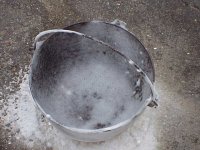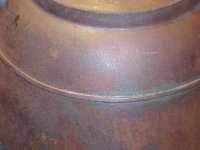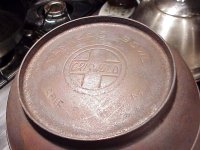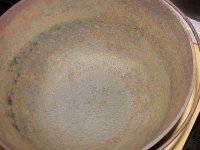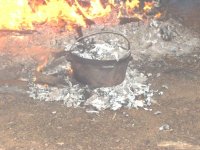Here the pot gets its second coating of oven cleaner. I am not making as much progress with this pot as I had hoped to. I am now into about 2 1/2 hours of cleaning time, not counting the amount of time that I was waiting for the oven cleaner to do its work.......
You are using an out of date browser. It may not display this or other websites correctly.
You should upgrade or use an alternative browser.
You should upgrade or use an alternative browser.
This Old Pot......
- Thread starter Junkman
- Start date
- Views: 4095
/ This Old Pot......
#11
This is the side trim ring after the second cleaning with the oven cleaner. The whole pot should look like the gray area when it is done. Not certain that I will be able to accomplish that. The rust is more difficult to remove than I have encountered in the past. This is the most difficult pot that I have ever worked on...
Attachments
This is the inside of the pot. As you can see this is deeply pitted and the pits are holding the rust. At this point, I broke out the heavy guns and used toilet bowl cleaner to remove the rust from the very worse of the pits. The toilet bowl cleaner is a acid and the oven cleaner is a alkali (lye), so as you can see, there are different ways to attack the problem. If I find that I don't get good results with the toilet bowl cleaner, then I will move onto using muriatic acid. The only problem with using acids other than the safety factor, is that they will also remove good metal along with the rust. For this reason, you have to be careful how long you keep it in contact with the cast iron. I have not worked on the sides of the pot very much yet, but I will continue on that tomorrow. The inside of the pot might require glass beading to get it to the point where it is ready for seasoning. All rust must be gone before seasoning, or the seasoning will not take very well.
Attachments
I decided to put some extra effort into the inside again and this is the final result for this evening. I have all the loose scale removed and the bottom is fairly flat at this point. Tomorrow I will use some emery paper to try to level some of the pits on the side of the pot. I might put it into the glass bead cabinet to see if that might help also. Since the pot was so badly pitted, I was afraid that there might be some pits that have broken through the wall of the pot, so I filled the pot with water and put it on the stove and brought it to a boil. If there were any pin holes, this would have exposed them and I would have seen weeping through the side. It appears that even though this pot is badly rusted and pitted, that after all this, it can once again be brought back to life and be used for cooking. Unfortunately the pits hurt the value of a pot to a collector, but for kitchen use, they will be of no consequence. I will post additional pictures as I do additional cleaning/restoration work to this. Stay tuned to "As the Pot Turns"...... Junk........ /forums/images/graemlins/grin.gif
Attachments
RobertN
Super Member
Would the electrolysis method using a battery charger work to loosen the rust?
In between steps, what do you do to prevent minor rust form happening?
You make a good point; too much contact with acid or base will eat the metal in addition to the rust. Will the bead blasting affect just the rust, or will it remove metal material too?
Curiously, you are putting a lot of work into this sample. How old is it, where was it made, ect? How much is it worth in the "rusty" state, and in the clean condition?
Looks like fun /forums/images/graemlins/laugh.gif
In between steps, what do you do to prevent minor rust form happening?
You make a good point; too much contact with acid or base will eat the metal in addition to the rust. Will the bead blasting affect just the rust, or will it remove metal material too?
Curiously, you are putting a lot of work into this sample. How old is it, where was it made, ect? How much is it worth in the "rusty" state, and in the clean condition?
Looks like fun /forums/images/graemlins/laugh.gif
I have never tried the electrolysis method of rust removal, but I have heard of it. I usually don't worry about surface rust forming while working on a pot, because with 5 minutes of a Brillo pad, it is gone. It is the deep rust that has to be removed. The nice thing about doing glass bead blasting, it doesn't hurt the metal and will only remove the loose rust, but not damage the underlying material. I use it on the turbines of the turbo chargers when I rebuild them. Cleans without damage. This pot was made by the Griswold Company back in the 1930's and is considered a rare piece, but for some reason they don't have as much value as some of the other pieces. I checked on the value after purchasing this pot and was told that it was worth about $85 in good condition. I just did a Google search for some idea of value, but I couldn't find any. I did find a website that recommended using a solution of vinegar and water to remove rust..... I might try that in the morning. If I felt energetic, I could try to sand the pits out of the cast iron, but I don't know if I have enough years left to finish the job. /forums/images/graemlins/grin.gif /forums/images/graemlins/grin.gif
daedong
Veteran Member
</font><font color="blue" class="small">( I did find a website that recommended using a solution of vinegar and water to remove rust..... I might try that in the morning )</font>
Junkman,
Vinegar is a very weak acid. I would expect it to be much less acidic than the toilet bowl cleaner you have already used. I don't think it will do much.
If you try it let us know how it works. And thanks for the photo story. Very interesting.
My neighbor once brought me a used cast iron griddle at a flea market. Had a nice black coating. I put it in the oven to burn this off. Stunk up the house. I can't prove it but I am sure that the piece had been "seasoned" with used motor oil to make it look nice. I threw it out. But if I knew about your oven cleaner trick I might have given it a try.
Phil
Junkman,
Vinegar is a very weak acid. I would expect it to be much less acidic than the toilet bowl cleaner you have already used. I don't think it will do much.
If you try it let us know how it works. And thanks for the photo story. Very interesting.
My neighbor once brought me a used cast iron griddle at a flea market. Had a nice black coating. I put it in the oven to burn this off. Stunk up the house. I can't prove it but I am sure that the piece had been "seasoned" with used motor oil to make it look nice. I threw it out. But if I knew about your oven cleaner trick I might have given it a try.
Phil
alan40
Platinum Member
Hey Junkman up here we use a food grade acid on our syrup pans. It really cleans them up and is pretty cheap. Vinegar/water or lemon juice with water will work also. Boil it and then pour out that mixture. To ensure that the acid/vinegar is neutralized put water and baking soda in the pot. Boil it or just swish it around the pot real well. Rinse again. That will neutralize the remaining acid in the pot.
Good luck.
Good luck.
